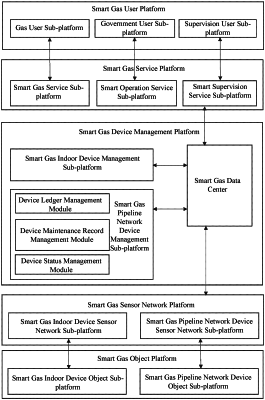| CPC H04L 67/12 (2013.01) [G16Y 10/35 (2020.01); G16Y 20/20 (2020.01)] | 7 Claims |

|
1. A method for predicting a filter element replacement at a gate station, wherein the method is implemented by an Internet of Things system for predicting the filter element replacement at the gate station, and the Internet of Things system includes a user platform, a service platform, a device management platform, a sensor network platform, and an object platform that interact in sequence, the device management platform includes a data center and a pipeline network device management sub-platform, and the method is executed by the device management platform, comprising:
obtaining, by the data center, usage information of the filter element through the sensor network platform, wherein the usage information at least includes at least one of ventilation efficiency of the filter element, filtered impurity information, and a blockage degree;
obtaining, by the pipeline network device management sub-platform, the usage information from the data center, determining a filter element maintenance plan based on the usage information, and sending the filter element maintenance plan to the data center;
sending, by the data center, the filter element maintenance plan to the user platform through the service platform; and
replacing the filter element according to the filter element maintenance plan,
wherein the filtered impurity information includes an accumulated amount of impurity filtering; and
the determining a filter element maintenance plan based on the usage information includes:
obtaining the accumulated amount of impurity filtering; and
determining the filter element maintenance plan based on the accumulated amount of impurity filtering;
wherein the obtaining the accumulated amount of impurity filtering includes:
determining an impurity feature based on an impurity prediction model, and determining the accumulated amount of impurity filtering based on the impurity feature, the impurity prediction model being a machine learning model including:
a first feature extraction layer, a gas flow prediction layer, a second feature extraction layer, and an impurity prediction layer, wherein
the first feature extraction layer is configured to obtain a first feature by processing usage duration, a diameter, and a usage pressure of the filter element;
the gas flow prediction layer is configured to determine a gas flow by processing the first feature, the gas flow being a total amount of gas passing through the filter element within a period of time;
the second feature extraction layer is configured to obtain a second feature by processing the gas flow, a gas intake quality, a filtration efficiency, and
a filtration precision; and the impurity prediction layer is configured to determine the impurity feature by processing the second feature;
wherein the first feature extraction layer and the gas flow prediction layer are obtained through joint training based on first training samples and a first label, wherein the first training samples include historical usage duration of sample filter element, diameter of the sample filter element, and usage pressure of the sample filter element and the first label includes an actual gas flow of the sample filter element, the joint training including:
inputting the first training samples into an initial first feature extraction layer and obtaining an output of the initial first feature extraction layer;
inputting the output of the initial first feature extraction layer into an initial gas flow prediction layer and obtaining an output of the initial gas flow prediction layer;
constructing a loss function based on the output of the initial gas flow prediction layer and the first label;
updating parameters of the initial first feature extraction layer and the initial gas flow prediction layer iteratively based on the loss function until a first preset condition is met; and
obtaining the first feature extraction layer and the gas flow prediction layer;
wherein the second feature extraction layer and the impurity prediction layer are obtained through joint training based on second training samples and a second label, wherein the second training samples include historical gas flow of sample filter element, historical gas intake quality of the sample filter element, filtration efficiency of the sample filter element, and filtration precision of the sample filter element, and the second label includes an actual impurity feature of the sample filter element, the joint training including:
inputting the second training samples into an initial second feature extraction layer and obtaining an output of the initial second feature extraction layer;
inputting the output of the initial second feature extraction layer into an initial impurity prediction layer and obtaining an output of the initial impurity prediction layer;
constructing a loss function based on the output of initial impurity prediction layer and the second label;
updating parameters of the initial second feature extraction layer and the initial impurity prediction layer iteratively based on the loss function until a second preset condition is met; and
obtaining the second feature extraction layer and the impurity prediction layer.
|